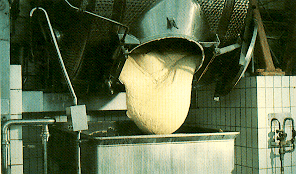 < Butter pouring from the churn
< Butter pouring from the churn

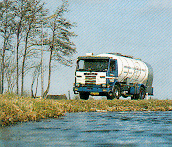
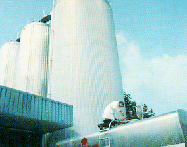
The milk is pumped from the cooling tank on the farm into a milk tanker. At the same time a sample of the milk is taken in order to check on its quality. Twenty or thirty ton milk tankers drive along the narrow country lanes to the creamery. There the river of milk, annualy arround eleven billion litres, is channeled in to two directories.
 < Butter pouring from the churn
< Butter pouring from the churn
Part of the milk has the fat removed by a cream separator. The cream is used
to make butter and cream. The residue, low fat milk, is used to make products
such as yoghurt, buttermilk or low fat milk.
The fat is not removed from the second stream of milk as this is used for full-fat products, including full-fat milk, cheese, condensed milk and milk powder. Semi-skimmed milk is produced by combining low-fat milk with some of the full-fat milk.
About a century ago the first cream separator was put into production, to skim the milk mechanically. In much the same way as a spin-dryer removes the water from your washing, the cream seperator spins the milk until the cream is removed. Prior to mechanisation the cream was removed after the milk had been left to stand in cool cellars, allowing the fat to rise to the surface. The milk fat which is removed forms the basic of butter. After the mechanisation of butter production it was no longer before cheese was also made in creameries, followed by products such as dairy ice-cream, milk powder, butter oil and condensed milk.
Nowadays the creameries produce a whole range of products. Yogurt and buttermilk have been around for a long time, but now desserts, milk-based drinks and cottage cheese have become very popular.
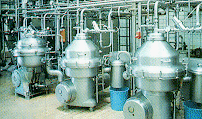
There are 110 Creameries in The Netherlands who process milk. Most specialise in fresh milk, milk-based products, milkpowder, or condensed milk. However, there are more specialized products being produced from whey, such as proteins and lactose. Hygiene and quality control of both the milk and dairy products also play an important role.
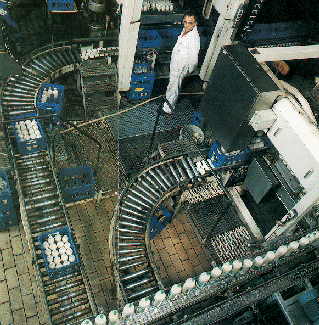 In modern creameries none of the milk is wasted. Walking into such a creamery
is like taking a step in to the twenty-first century, with stainless steal
vats, pipes ans large control panels from which the complete production
process is monitored. In fact there is only one thing to remind you of the
old-fashioned dairy, with its wooden vats, brass, ladles and spoons; the
typical 'dairy' aroma. Thanks to this aroma we are reminded that in spite of
the advances of technology and computers, milk and its by-products remain a
traditional food.
In modern creameries none of the milk is wasted. Walking into such a creamery
is like taking a step in to the twenty-first century, with stainless steal
vats, pipes ans large control panels from which the complete production
process is monitored. In fact there is only one thing to remind you of the
old-fashioned dairy, with its wooden vats, brass, ladles and spoons; the
typical 'dairy' aroma. Thanks to this aroma we are reminded that in spite of
the advances of technology and computers, milk and its by-products remain a
traditional food.